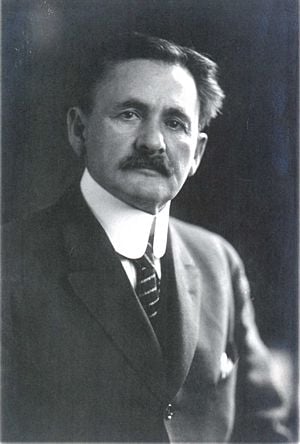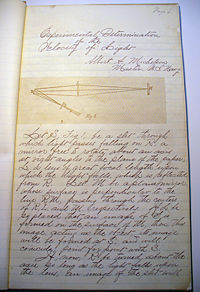Albert Abraham Michelson
|
Albert Abraham Michelson | |
|---|---|
 Albert Abraham Michelson | |
| Born |
December 19 1852 |
| Died | May 9 1931 (aged 78) Pasadena, California |
| Residence | |
| Nationality | |
| Ethnicity | Jewish-Polish |
| Field | Physicist |
| Institutions | Case Western Reserve University Clark University University of Chicago |
| Alma mater | US Naval Academy University of Berlin |
| Academic advisor | Hermann Helmholtz |
| Notable students | Robert Millikan |
| Known for | Speed of light Michelson-Morley experiment |
| Notable prizes | |
Albert Abraham Michelson (surname pronunciation anglicised as "Michael-son") (December 19, 1852 – May 9, 1931) was a Prussian-born American physicist known for his work on the measurement of the speed of light and especially for the Michelson-Morley experiment. In 1907 he received the Nobel Prize in Physics, the first American to receive the Nobel in the sciences.
Life
Michelson, the son of a Jewish merchant, was born to a Jewish family in what is today Strzelno, Poland (then Strelno, Provinz Posen in the Prussian-occupied region of partitioned Poland). He moved to the United States with his parents in 1855, when he was two years old. He grew up in the rough mining towns of Murphy's Camp, California, and Virginia City, Nevada, where his father was a merchant. It was not until age 11 that he began formal schooling in San Francisco.
Upon special appeal, President Ulysses S. Grant awarded Michelson an appointment to the U.S. Naval Academy in 1869. During his four years as a midshipman at the Academy, Michelson excelled in optics, heat and climatology as well as drawing. After his graduation in 1873 and two years at sea, he returned to the Academy in 1875 to become an instructor in physics and chemistry until 1879. From 1880 to 1882, Michelson undertook postgraduate study at Berlin under Hermann Helmholtz and at Paris.
Michelson was fascinated with the sciences and the problem of measuring the speed of light in particular. While at Annapolis, he conducted his first experiments of the speed of light, as part of a class demonstration in 1877. After two years of studies in Europe, he resigned from the Navy in 1881. In 1883 he accepted a position as professor of physics at the Case School of Applied Science in Cleveland, Ohio and concentrated on developing an improved interferometer. In 1887 he and Edward Morley carried out the famous Michelson-Morley experiment which seemed to rule out the existence of the aether. He later moved on to use astronomical interferometers in the measurement of stellar diameters and in measuring the separations of binary stars.
In 1889 Michelson became a professor at Clark University at Worcester, Massachusetts and in 1892 was appointed professor and the first head of the department of physics at the newly organized University of Chicago.
In 1899, he married Edna Stanton and they raised one son and three daughters.
In 1907, Michelson had the honor of being the first American to receive a Nobel Prize in Physics "for his optical precision instruments and the spectroscopic and metrological investigations carried out with their aid." He also won the Copley Medal in 1907, the Henry Draper Medal in 1916 and the Gold Medal of the Royal Astronomical Society in 1923. A crater on the Moon is named after him.
Michelson died in Pasadena, California at the age of 78. The University of Chicago Residence Halls remembered Michelson and his achievements by dedicating Michelson House in his honor. Case Western Reserve has also dedicated a Michelson House to him, and an academic building at the United States Naval Academy also bears his name. Michelson Laboratory at Naval Air Weapons Station China Lake in Ridgecrest, California is named after him. There is an interesting display in the publicly accessible area of the Lab of Michelson's Nobel Prize medal, the actual prize document, and examples of his diffraction gratings.
Speed of light
Early measurements
As early as 1877, while still serving as an officer in the US Navy, Michelson started planning a refinement of the rotating-mirror method of Léon Foucault for measuring the speed of light, using improved optics and a longer baseline. He conducted some preliminary measurements using largely improvised equipment in 1878 about which time his work came to the attention of Simon Newcomb, director of the Nautical Almanac Office who was already advanced in planning his own study. Michelson published his result of 299,910±50 km/s in 1879 before joining Newcomb in Washington DC to assist with his measurements there. Thus began a long professional collaboration and friendship between the two.
Newcomb, with his more adequately funded project, obtained a value of 299,860±30 km/s, just at the extreme edge of consistency with Michelson's. Michelson continued to "refine" his method and in 1883 published a measurement of 299,853±60 km/s, rather closer to that of his mentor.
Mount Wilson and Lookout Mountain 1920
In 1906, a novel electrical method was used by E. B. Rosa and N. E. Dorsey of the National Bureau of Standards to obtain a value for the speed of light of 299,781±10 km/s. Though this result has subsequently been shown to be severely biased by the poor electrical standards in use at the time, it seems to have set a fashion for rather lower measured values.
From 1920, Michelson started planning a definitive measurement from the Mount Wilson Observatory, using a baseline to Lookout Mountain, a prominent bump on the south ridge of Mount San Antonio (Old Baldy), some 22 miles distant.
In 1922, the U.S. Coast and Geodetic Survey began two years of painstaking measurement of the baseline using the recently available invar tapes. With the baseline length established in 1924, measurements were carried out over the next two years to obtain the published value of 299,796±4 km/s.
Famous as the measurement is, it was beset by problems, not least of which was the haze created by the smoke from forest fires which blurred the mirror image. It is also probable that the intensively detailed work of the Geodetic Survey, with an estimated error of less than one part in 1 million, was compromised by a shift in the baseline arising from the Santa Barbara earthquake of 29 June 1925 which was an estimated magnitude of 6.3 on the Richter scale.
Michelson, Pease & Pearson 1932
The period after 1927 marked the advent of new measurements of the speed of light using novel electro-optic devices, all substantially lower than Michelson's 1926 value.
Michelson sought another measurement but this time in an evacuated tube to avoid difficulties in interpreting the image owing to atmospheric effects. In 1930, he began a collaboration with Francis G. Pease and Fred Pearson to perform a measurement in a 1.6 km tube at Pasadena, California. Michelson died with only 36 of the 233 measurement series completed and the experiment was subsequently beset by geological instability and condensation problems before the result of 299,774±11 km/s, consistent with the prevailing electro-optic values, was published posthumously in 1935.
Interferometry
In 1887, he collaborated with colleague Edward Williams Morley in the Michelson-Morley experiment. Their experiment for the expected motion of the Earth relative to the aether, the hypothetical medium in which light was supposed to travel, resulted in a null result. Though it may appear that Albert Einstein did not know of the work (according to his 1905 paper), it greatly assisted the acceptance of the theory of relativity...
Astronomical interferometry
In 1920-21, Michelson and Francis G. Pease famously became the first people to measure the diameter of a star other than our Sun. They used an astronomical interferometer at the Mount Wilson Observatory to measure the diameter of the super-giant star Betelgeuse. A periscope arrangement was used to obtain a densified pupil in the interferometer, a method later investigated in detail by Labeyrie for use in with "Hypertelescopes." The measurement of stellar diameters and the separations of binary stars took up an increasing amount of Michelson's life after this.
The home in which Michelson lived as a child in Murphys Camp, California (present-day Murphys, California) is now a tasting room for Twisted Oak Winery.
Awards and honors
- Royal Society
- National Academy of Sciences
- American Physical Society
- American Association for the Advancement of Science
- Nobel Prize for Physics (1907)
- Rumford Prize (1888)
- Matteucci Medal (1903)
- Copley Medal (1907)
- Gold Medal of the Royal Astronomical Society (1923)
- The Computer Measurement Group gives an annual A. A. Michelson award
Electronic books
- Works by Albert Abraham Michelson. Project Gutenberg
- Experimental Determination of the Velocity of Light
ReferencesISBN links support NWE through referral fees
- Livingston, D. M. The Master of Light: A Biography of Albert A. Michelson. ISBN 0-226-48711-3. (Biography by Michelson's daughter.)
See also
- Light
- Optics
External links
- Albert A. Michelson 1852-1931
- Albert Abraham Michelson National Academy of Science
- Michaelson's Life and Works from the American Institute of Physics
- U. S. Naval Academy and The Navy
- Michelson House at the University of Chicago
| ||||||||
| Persondata | |
|---|---|
| NAME | Michelson, Albert Abraham |
| ALTERNATIVE NAMES | |
| SHORT DESCRIPTION | Physicist |
| DATE OF BIRTH | December 29, 1852 |
| PLACE OF BIRTH | Strzelno, Poland |
| DATE OF DEATH | May 9, 1931 |
| PLACE OF DEATH | Pasadena, California |
Credits
New World Encyclopedia writers and editors rewrote and completed the Wikipedia article in accordance with New World Encyclopedia standards. This article abides by terms of the Creative Commons CC-by-sa 3.0 License (CC-by-sa), which may be used and disseminated with proper attribution. Credit is due under the terms of this license that can reference both the New World Encyclopedia contributors and the selfless volunteer contributors of the Wikimedia Foundation. To cite this article click here for a list of acceptable citing formats.The history of earlier contributions by wikipedians is accessible to researchers here:
The history of this article since it was imported to New World Encyclopedia:
Note: Some restrictions may apply to use of individual images which are separately licensed.


